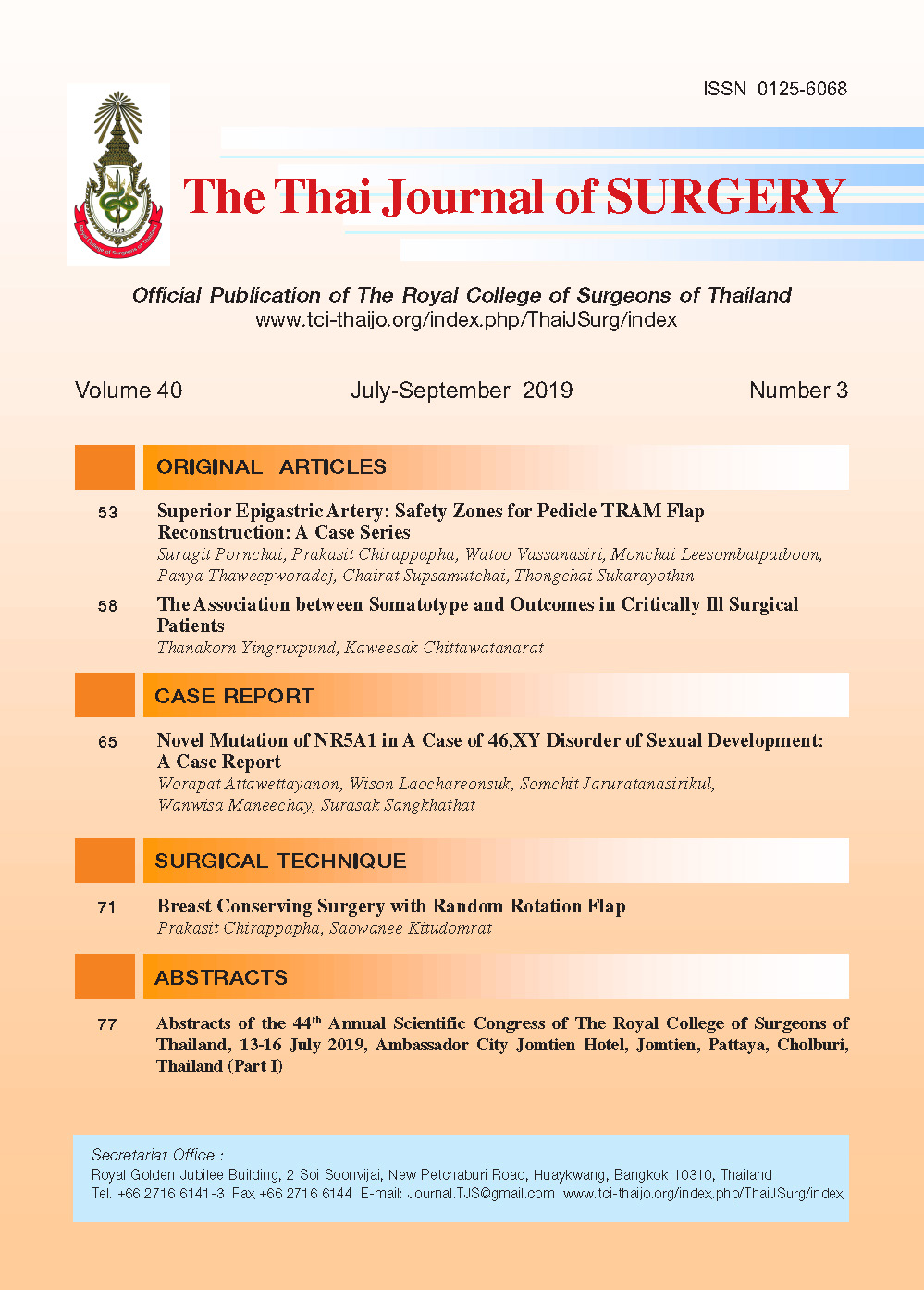Superior Epigastric Artery: Safety Zones for Pedicle TRAM Flap Reconstruction: A Case Series
Keywords:
Immediate autologous flap reconstruction, Deep superior epigastric artery, Transverse rectus abdominis musculocutaneous flapAbstract
Deep superior epigastric artery (DSEA) can be damaged in pedicled transverse rectus abdominis musculocutaneous (TRAM) flap reconstruction. Current descriptions of the course of the DSEA do not provide surface landmarks that would be of help to the surgeon. Surface markings of the deep inferior epigastric artery (DIEA) with description safe zones of the TRAM flap are available in the literature, but this is not the case for the DSEA. This study aimed to map surface markings for the DSEA and identify the “danger zone”, which must be avoided during pedicled TRAM flap reconstruction.
References
2. Hallock GG. The superior epigastric(RECTUS ABDOMINIS) muscle perforator flap. Ann Plast Surg 2005;55:430-2.
3. Miller LB, Bostwick J, 3rd, Hartrampf CR, jr, et al. The superiorly based rectus abdominis flap: predicting and enhancing its blood supply based on an anatomic and clinical study. Plast Reconstr Surg 1988;81:713-24.
4. Taylor GI. The angiosomes of the body and their supply to perforator flaps. Clin Plast Surg 2003;30:331-42.
5. Taylor GI, Palmer JH. The vascular territories (angiosomes) of the body: experimental study and clinical applications. Brit J Plast Surg 1987;40:113-41.
6. McCraw JB. Perforator flaps: anatomy, technique, and clinical applications. Plast Reconstr Surg 2006;118:552-3.
7. Joy P, Prithishkumar IJ, Isaac B. Clinical anatomy of the inferior epigastric artery with special relevance to invasive procedures of the anterior abdominal wall. J Minimal Access Surg 2017;13:18-21.
8. Lachman N, Satyapal KS. Origin and incidence of xiphoid branch of the internal thoracic artery. Surgical and radiologic anatomy: SRA. 1999;21:351-4.
9. Whetzel TP, Huang V. The vascular anatomy of the tendinous intersections of the rectus abdominis muscle. Plast Reconstr Surg 1996;98:83-9.
10. Yurdakul M, Tola M, Ozdemir E, et al. Internal thoracic artery-inferior epigastric artery as a collateral pathway in aortoiliac occlusive disease. J Vasc Surg 2006;43:707-13.
11. Al Talalwah W. A new concept and classification of corona mortis and its clinical significance. Chinese J Traumatol 2016;19:251-4.
12. Moon HK, Taylor GI. The vascular anatomy of rectus abdominis musculocutaneous flaps based on the deep superior epigastric system. Plast Reconstr Surg 1988;82:815-32.
13. Slavin SA, Goldwyn RM. The midabdominal rectus abdominis myocutaneous flap: review of 236 flaps. Plast Reconstr Surg 1988;81:189-99.
14. Little JW. Breast reconstruction by the unipedicle tram operation: muscle splitting technique. Surgery of the Breast: Principles and Art. 1998:521–33.
15. Kroll SS, Marchi M. Comparison of strategies for preventing abdominal-wall weakness after TRAM flap breast reconstruction. Plast Reconstr Surg 1992;89:1045-51.
16. Ducic I, Spear SL, Cuoco F, et al. Safety and risk factors for breast reconstruction with pedicled transverse rectus abdominis musculocutaneous flaps: a 10-year analysis. Ann Plast Surg 2005;55:559-64.
17. Vasquez JM, Demarque AM, Diamond MP. Vascular complications of laparoscopic surgery. J Am Assoc Gynecol Laparosc 1994;1:163-7.
18. Hallock GG. Doppler sonography and color duplex imaging for planning a perforator flap. Clin Plast Surg 2003;30:347-57.
19. Masia J, Clavero JA, Larranaga JR, et al. Multidetector-row computed tomography in the planning of abdominal perforator flaps. JPRAS 2006;59:594-9.
20. Nordestgaard AG, Bodily KC, Osborne RW, Jr., et al. Major vascular injuries during laparoscopic procedures. Am J Surg 1995;169:543-5.
Downloads
Published
How to Cite
Issue
Section
License
Articles must be contributed solely to The Thai Journal of Surgery and when published become the property of the Royal College of Surgeons of Thailand. The Royal College of Surgeons of Thailand reserves copyright on all published materials and such materials may not be reproduced in any form without the written permission.


